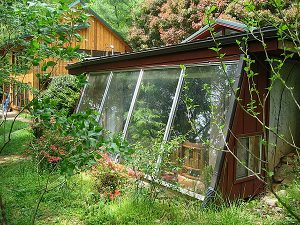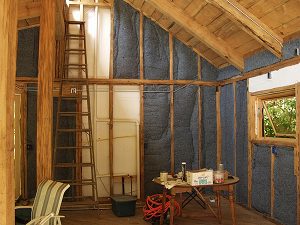By Kimber Ray
For Patrick Ironwood, the point where the Sweet Gum Gateway home ends and the wild lands of the Cumberland Plateau begin is blurred, with the sweeping porch and edible landscape of Sweet Gum elegantly blending with the natural environment.
Sweet Gum is just one of many such exemplary homes at the Sequatchie Valley Institute, a learning center for sustainable living in southeast Tennessee where members can pay to take on residential internships. Within the institute’s 300 acres of steep bluffs and verdant forests, members are participating in research and workshops on ecology, agriculture and architectural design.
Ironwood is the institute’s director of landscape and design. As a lifelong resident of the center, he has developed an earnest enthusiasm for the ecological design system known as permaculture. In order to promote living in harmony with nature, permaculture methods aim to balance the needs of humans, plants, animals and the Earth. Ironwood applied these concepts when he began work on the Sweet Gum home in 1998, using a blueprint from the sustainable living magazine, Mother Earth News.
“A lot of times a house may take away from a beautiful, natural place,” Ironwood comments. “This house has really allowed us to live here in this natural place and become a part of it even more.”
In fact, even the wood used to build Sweet Gum is sourced directly from the surrounding land. After a southern pine beetle outbreak in the 1990s, thousands of trees were killed. The wood from trees that had fallen or died was then salvaged and used in constructing the house.

A window into energy efficiency: the south-facing greenhouse soaks up the sun while the earthen sidewalls provide insulation. Photo by Patrick Ironwood
In addition to locally sourced timber, Sweet Gum makes use of the landscape through passive solar design — an architectural approach used to efficiently distribute solar energy throughout the house. The techniques are considered passive, rather than active, because this is done without the use of mechanical or electrical devices. Different elements of construction — such as the orientation of the house to the sun and the type of building materials — work together to keep the house warm in the winter and cool in the summer.
At Sweet Gum, large windows were placed on the south-facing side of the house to receive the maximum amount of sunlight during the winter. This abundance of natural light bathing the house throughout the day is used to nourish an attached greenhouse, allowing garden plants to be started in the late winter. The walls of the greenhouse are made of cob, a mixture of clay, soil, sand and straw. Earth materials such as soil have a high thermal mass, meaning that they are dense enough to resist rapid temperature change and can efficiently store and release solar heat.
During the summer months, the house is given respite from the heat by shade provided from an overhang on the roof as well as nearby deciduous trees. Because the sun travels along a lower path in the sky during the winter, the angle of the overhang is designed to allow the rays of winter sun in, while keeping the rays of summer sun out.
On the north side of the house, a technique called earth berming uses the high thermal mass of earth materials as insulation. Piles of soil are packed against the fortified outside wall to form an insulating cocoon that shields the house from outdoor temperatures.

Recycled blue jean scraps provide safe and effective insulation for the Sweet Gum Gateway. Photo by Patrick Ironwood
Environmentally friendly insulation was also used for the interior of the house. Denim insulation, made from recycled blue jeans, provides a safe and efficient alternative to fiberglass. Although the research required for choosing the best design and materials for a home can be very time consuming, Ironwood says, “it’s well worth it in the end.”
“Anyone that builds using these materials will learn a lot more about the house that they’re living in, and suddenly you aren’t living in a house that someone else built, you’re really a part of it,” he says. “That gives the sense that you actually have a relationship with the system that you’re living in.”
Ironwood advises that even those who aren’t building their homes from the bottom-up can make important strides towards sustainability. Taking simple steps, such as recycling and monitoring energy use, can pave the way for a healthier relationship between humans and the natural environment.
More info: To learn more about the Sequatchie Valley Institute, visit svionline.org.
Related Articles
Latest News

Leave a comment
Your email address will not be published. Required fields are marked *




